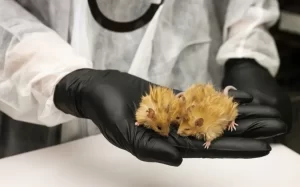With curly whiskers and wavy, light hair that grows three times longer than that of an ordinary lab mouse, the genetically modified rodent embodies several woolly mammoth-like traits, according to Colossal Biosciences. The private Dallas company is behind efforts to resurrect the mammoth and other extinct animals.
Colossal said its woolly mouse would enable its scientists to test hypotheses about the link between specific DNA sequences and physical traits that enabled the mammoth, which went extinct around 4,000 years ago, to adapt to life in cold climates.
“It is an important step toward validating our approach to resurrecting traits that have been lost to extinction and that our goal is to restore,” said Dr. Beth Shapiro, chief science officer at Colossal, in a news release Tuesday. Shapiro is currently on a leave of absence from her role as professor of ecology and evolutionary biology at the University of California, Santa Cruz.
How to make a woolly mouse
To create the woolly mouse, Colossal said it had identified genetic variants in which mammoths differed from their closest living relative: the Asian elephant.
The company’s scientists then pinpointed 10 variants related to hair length, thickness, texture, color and body fat that corresponded to similar, known DNA variants in a lab mouse.
For example, scientists targeted a gene known as FGF5 (fibroblast growth factor 5), which targets the cycle of hair growth, creating longer, shaggy hair. They also altered the function of three genes related to hair follicle development and structure to create woolly hair texture, wavy coats and curled whiskers, the company said in a news release.
Other target genes included MC1R (melanocortin 1 receptor), which regulates melanin production, in order to produce mice with golden hair rather than the usual dark fur and a variant associated with changes in body weight.
In total, the team made eight edits simultaneously, using three cutting-edge techniques, to seven mice genes.
Colossal shared an unpublished, or preprint, scientific paper describing the research, which has not undergone peer review.
“I think that the ability to edit multiple genes at the same time in mice, and to do so and obtain the expected woolly appearance, is a very important step,” said Love Dalén, a professor of evolutionary genomics at Stockholm University. Dalén is an advisor to Colossal and was a coauthor on the paper.
“It is a proof-of-principle that Colossal has the know-how to do this kind of gene editing, including to insert mammoth gene variants into a different species.”
Just ‘cute, hairy-looking mice’?
The research outlined in the unpublished paper was technically impressive and the genetic changes precise and efficient, said Robin Lovell-Badge, head of the Stem Cell Biology and Developmental Genetics Laboratory at The Francis Crick Institute in London.
“My biggest problem with the paper is that there is nothing addressing whether the modified mice are cold-tolerant — through introducing traits that are apparent in mammoths — which is the justification given for carrying out the work,” Lovell-Badge said via email.
“As it is, we have some cute looking hairy mice, with no understanding of their physiology, behaviour, etc. It doesn’t get them any closer to know if they would eventually be able to give an elephant useful mammoth-like traits and we have learned little biology.”



